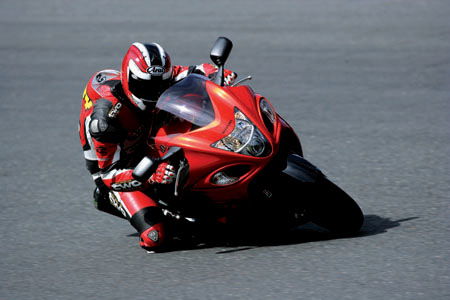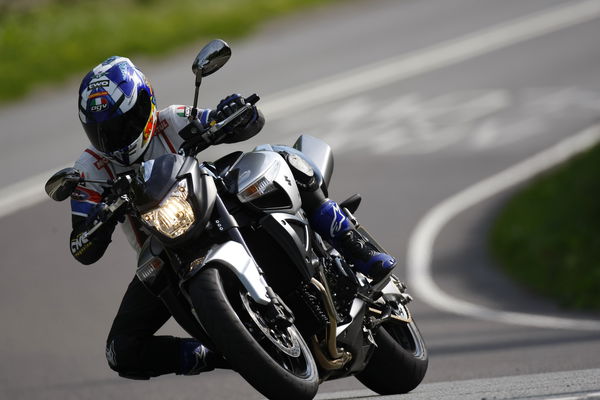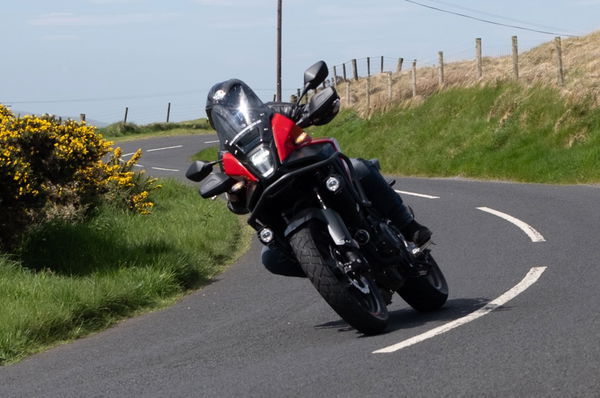First Ride: Suzuki GSX1300R Hayabusa
With a tyre-shredding 194bhp on tap and a fully revised chassis the original Hypersports bike is refusing to grow old gracefully. Hold on tight, because the 'Busa is back and is meaner than ever...

 |
Somewhere in my body the electrical connection between my brain and my throttle hand is getting lost. I'm not 100% sure where the short circuit is, but I'm almost certain that the muscle-contracting pulse of energy that should be making my wrist turn is, in fact, being re-routed to constrict my sphincter instead. This doesn't really come as much of a surprise, I'm heading into a corner on Suzuki's new Hayabusa flat out in 6th gear after all...
In the grand scheme of things I might be exaggerating a bit on this one. It's more of a kink than a full-blown corner, but when the speedo needle is well past the 280kph (170mph) mark even a gentle bend takes some mastering. Ah, here we are...
For the first real update of the Hayabusa since it's original launch in 1998, Suzuki decided to unleash us on the Salzburgring. Those of you who are into racing will know that this historic Austrian track used to host GPs and has seen many a titanic battle between racing's greats. Well it did until the early '90s when it was withdrawn from the GP calendar due to organisers deciding that its sheer speed, not to mention the proximity of Armco barriers, were a safety issue. Sounds like the perfect spot to test out the world's fastest production bike to me!
But subtle was never really on the cards with the Hayabusa, there is absolutely nothing even remotely subtle about this monster. From it's wacky yet aerodynamic 'someone parked me too close to a radiator and I've melted' fairing to its insane power figures, this is a bike that screams 'look at me.' Which is one of its key selling points. Bizarrely, and this is certainly a first when it comes to press launches, the Japanese R&D man happily showed pics of tricked up 'Busas while proudly announcing that the bike was the star of many rap videos. He then proceeded to declare that the Hayabusa was designed to have the highest performance of any road bike with a whopping 194bhp and 114lb.ft of torque. In an age where speeding is about as socially acceptable as admitting to being a practising racist this was a bold statement indeed.
But I tell you what, he had good reason to have some fatherly pride in the new Hayabusa, because I can't see how it won't be the most powerful bike out there. It's a total rocket ship. And a little bit more.
To all intents and purposes the Salzburgring is two very long straights with large hairpins at either end. While only one of them is truly straight, the other is effectively straight as it has three quite open bends that can (bravery allowing) be taken virtually flat out. Exiting the second gear hairpin onto the back (wobbly) straight the 'Busa starts to accelerate like only a Hayabusa can. The engine makes a fantastic 'whoop' sound that is so reminiscent of the old bike. It's a completely different set of acoustics to the rest of the GSX-R range and rather than a screaming airbox the huge twin pipes behind you seem to be morphing into afterburners, propelling you even faster down the road.
And Christ does this bike shift. Second is over and done with almost before you know what is happening, into third it's still pulling like a train, fourth and there is no let up, by the time the new gear indicator is showing fifth the bloody thing is still going strong and this surge of acceleration doesn't even stop in sixth. It's totally mental and completely addictive.
From the very first Hayabusa Suzuki has managed to create a motor that feels more like a giant turbine rather than an inline four. It doesn't scream, hit power bands or even really vibrate that much like most big fours. It's just stacked with smooth and horrifically fast power. Well the 2008 bike is this, but even more.
While it is the extra capacity that has grabbed the headlines, up from 1299cc to 1340cc, that's just the tip of the iceberg. The whole engine has been redesigned with lighter pistons, new conrods, crank, titanium valves, new cylinders, the works. So as well as more power and torque, the engine revs faster and does it with even more refinement.
It is without a doubt a monster of a power plant, but also remarkably civilised, like the rest of the bike. Although 'Busa owners relish the kick of acceleration they also demand a certain amount of comfort in their steed. This is, after all, a tourer of sorts, just a bloody stupidly quick one.
As well as refining the fuel injection to give a smooth initial power delivery (something you want when 194bhp chimes in) Suzuki hasn't abandoned the 'Busa's touring side. As well as a thickly padded seat the screen is 15mm higher than before, meaning you can now actually read the clocks without ducking behind it, and offers a decent amount of wind protection. Even at supersonic speeds you don't have to stoop so low that your chin hits the tank just to prevent your head getting ripped off, which is very impressive. And while the rider's seating position remains the same as before, the pillion's is 17mm lower, meaning they have a fighting chance of not getting swept clean off the back when the rider gets a bit excited with the throttle. In addition the fairing is slightly wider to improve the bike's aerodynamics and provide even more shelter for the rider. And the Hayabusa now comes with Suzuki's remarkably useless three-step adjustable power mode gizmo.
As with the new GSX-R1000 you get full power, semi-full power and very reduced power modes on the Hayabusa. As with the GSX-R I find it fairly pointless, but it works well enough if you fancy making your 'Busa feel like it has something stuck in its intakes pop it in 'C' mode. It only has a top speed of 130mph in this mode, which should merely get you a lengthy ban rather than the few weeks inside playing bride to your new room mate as getting caught topping out 'A' mode will get you. But then, who would ever catch you at 186mph?
Which is why Suzuki chose to unveil it to us on a circuit rather than the open road. Journalists can't be trusted and the original 'Busa launch had a few 'incidents' involving police and large speeding fines, and that was when speeding was less of an issue. But it gave us a chance to push the new chassis.
Bearing in mind that this is essentially a touring bike I won't make a big fuss of its lack of ground clearance. On track you will grind the hero blobs and if you get carried away then the huge pipes can end up meeting terra firma, too. The thickly rubber covered pegs are a matter of preference. Personally I hate them because my foot has a nasty habit of slipping off the peg mid-corner, but for touring they absorb vibrations and are more comfortable than metal pegs.
But a problem the track did highlight was the brakes, or slight lack of them. Hayabusa's have never had particularly good brakes. The old bike's six-piston calipers looked good, but lacked power and feel. For 2008 Suzuki has updated the forks and given the 'Busa a natty set of radial calipers, just like the GSX-R1000. Unfortunately they don't impress.
Braking hard, down from speeds around the 170mph mark into the second gear chicane, the front brake developed a nasty sponginess after a few laps as it overheated. Although it never got to the point of totally losing power, it did give me a few scares as the pressure drop was enough to make the lever come back enough to trap those fingers that weren't doing the braking against the bar. Not ideal at these speeds. On a UK track I'm sure you would struggle to recreate the kind of continual hard braking we did at the Salzburgring but even at lower speeds I was less than impressed with the feel of the brakes. It might just be that bikes such as Ducati's 1098 and Honda's Fireblade have moved the game on another step when it comes to braking precision, but while the performance was there the Hayabusa's front brake never offered anything like the quality of feel I was hoping for. If I owned one and was looking at doing a few track days I'd certainly swap the pads and then possibly look at changing the brake lines for steel braided items, because track days are certainly on the cards with the Hayabusa.
Ground clearance aside the chassis is remarkably good considering it size. Suzuki has resisted changing it too much from the original bike (wheelbase, rake and trail are all identical) and has instead lightened the frame and added extra strength to the swingarm to deal with the power increase. The 'Busa has always been the sportiest of the Hyperbikes and while it still feels quite long it's by no means a bad track bike. I found that adding two clicks to all of the standard suspension settings firmed the bike up sufficiently to take out the saggy feeling and made it handle considerably better.
Tipping into corners, even on the brakes, the front end felt secure and exiting the sorted fuel injection and impressively sticky Bridgestone BT-015 tyres meant that you could power hard out of the corners in relative safety. But don't get cocky. On a few occasions, mainly when the tyres were really starting to get over worked near the end of a session, the rear would break free, but it only ever did it when you really put the power down, so it wasn't exactly unexpected, especially with 194bhp being unleashed on it.
Having taken so long to get around to redesigning the Hayabusa it isn't surprising that Suzuki has got it spot on. There isn't much wrong with the current bike but the new model manages to improve in all aspects. The engine is stunning, handling very good and annoying quirks such as the low screen ironed out. The only question mark for me hangs over the brakes, but I'm fairly confident that for road riding they will be perfectly fine, if a little lacking in finesse. Is it better than Kawasaki's ZZR1400? Personally I found the Kawasaki slightly lacking in the bottom end, which isn't something the Suzuki could be accused of, but there again race tracks are very good at hiding low end issues, especially a track as fast as the Salzburgring. Might see if I can obtain a foreign driving licence for the UK comparison test...
THE HAYABUSA STRIPPED DOWN
As well as a capacity increase from 1299cc to 1340cc through a 2mm longer stroke, the Hayabusa's engine has a special bore coating to reduce internal friction and new three-ring forged aluminium-alloy slipper pistons that are 1.4 grams lighter than before. Compression is raised from 11.5:1 to 12.5:1 while the con rods are stronger to deal with the extra power. Titanium valves replace the previous model's steel ones, reducing each intake valve's weight by 14.1 grams and exhaust valve's by 11.7 grams. Valve lift has been increased. And the cooling system is improved with a new radiator. The net result is a claimed power gain of 22bhp to 194bhp with 13lb.ft of torque to 114lb.ft.
The chassis has been left virtually unchanged with the frame only slightly lightened due to the removal of some brackets, it has the same geometry as before, while the subframe is new with the pillion sitting 17mm lower than before. The swingarm's torsional strength is up 10% with a new design while the 43mm forks and radial brakes are new.
Regards styling, the fairing is wider and the screen 15mm taller while the indicators have been integrated into the bodywork.
SPECS
TYPE - HYPERSPORTS
PRODUCTION DATE - 2007
PRICE NEW - £8995
ENGINE CAPACITY - 1340cc
POWER - 194bhp@9500rpm
TORQUE - 114lb.ft@7200rpm
WEIGHT - 220kg
SEAT HEIGHT - 805mm
FUEL CAPACITY - 21L
TOP SPEED - 186mph
0-60 - n/a
TANK RANGE - N/A











